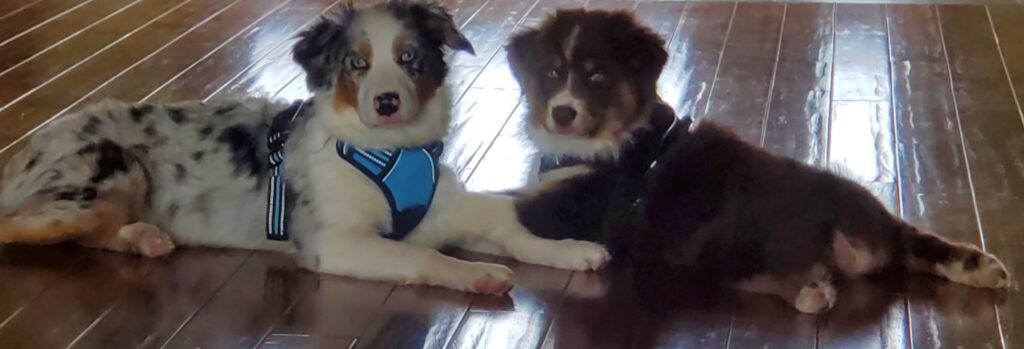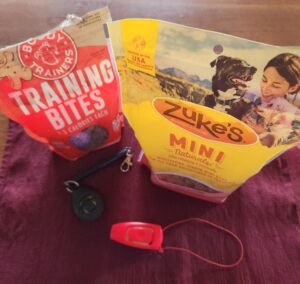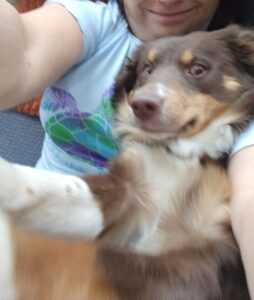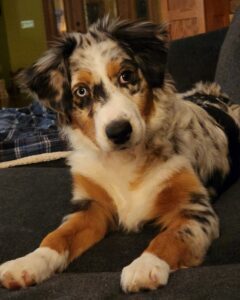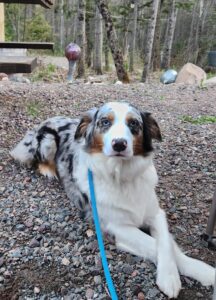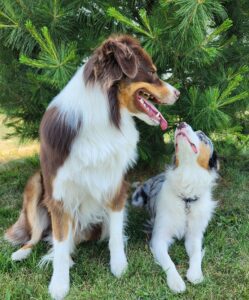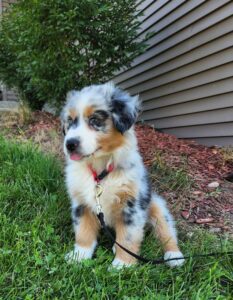Your puppy now depends on you for everything – food, water, exercise, training, health, and hygiene. It’s important to understand that each puppy is unique, so consulting with your veterinarian and trainer for your puppy’s specific needs is essential.
Bringing your puppy home is an exciting moment, and you’ll naturally want to introduce them to your friends and play with them right away. However, it’s crucial to give your puppy some time to adjust to their new surroundings. We recommend at least three days at home without visitors or outings. This initial period of calmness is important for your puppy as they adapt to all the changes. Adding extra stress during this transition can be detrimental to their mental and physical well-being.
Remember puppies do not understand English or any language. The most effective way to train a dog is to praise them when they exhibit the desired behavior, whether through pats, treats, or verbal praise (keep it simple like “Yes”) For example, avoid repeatedly saying “Sit…sit…sit…sit…SIT” and expecting an immediate response. Instead, encourage your puppy to perform the behavior (sit) and then reward them. You can introduce the command word (which should only be said once) and even a hand signal later in the training process.
Chewing
Puppies come equipped with needle-sharp teeth, and managing their teething phase can be quite challenging. Here are some tips to help you avoid being a pincushion:
- Keep Chew Toys Handy: Always have chew bones and toys readily available (see the puppy shopping list for recommended toys). Don’t allow them to chew on you. Consistency is key; if one family member permits this behavior, your puppy may think it’s acceptable, which could lead to them considering toddlers as chew toys as well.
- Enforce Consistent Rules and Boundaries: Maintain consistent rules and boundaries for your puppy. If they start chewing on you, offer them an appropriate item to chew on instead. If they continue, remove yourself from their presence (stand up and walk away or turn your back to them). Puppies don’t want to lose their human companions, so this can be an effective strategy.
- Use a sharp “Puppy Cry” Noise: Mimicking the sharp cry puppies make when something hurts can be effective. This noise is how they communicate discomfort to their littermates. When your puppy bites too hard, make a quick, high-pitched noise to let them know it’s painful.
These strategies should help you navigate the teething phase and teach your puppy proper bite inhibition.
Feeding
By the time your puppy comes home, their feeding schedule will be reduced to three times a day (morning, afternoon, & evening). The amount you should feed your new puppy will depend on the specific kibble you’re using and should align with your puppy’s weight and age. Follow the feeding guidelines provided on the packaging of the dog food you’ve selected for your puppy. These guidelines are tailored to ensure your puppy receives the appropriate nutrition for their specific age and size. Premium dog food has a higher nutritional density, so you can feed your dog less to achieve the same results.
First-Year Timeline
8 weeks to 6 months – During this period, feed your puppy three times per day. By 12 weeks, your puppy should start losing that potbelly and pudginess. Monitor your puppy’s body condition to determine portion sizes rather than the amount left in the bowl. Most dogs tend to finish meals quickly. To discourage picky habits, establish regular feeding times and amounts, and avoid leaving the food bowl down for more than 20 minutes if food is remaining. Refer to the chart below for appropriate weight guidelines for standard Australian Shepherds.
Important: It’s crucial not to switch your puppy to a different brand of puppy food immediately after bringing them home. A sudden change in diet can potentially cause an upset to their digestive system. The recommendation is to continue the puppy on the breeder’s food (see the puppy shopping list for our choice) for at least two weeks. If you decide to transition to a different brand after that timeframe, it should be done gradually over nine days. First three days—75% of current food and 25% of new food. Next three days—50% of current food and 50% of new food. Last three days—25% of current food and 75% of new food. On the tenth day, provide 100% of new food.
6-12 months: Transition to feeding your puppy twice a day, typically in the morning and evening, as they continue to grow.
Age 1 to 14 months: As your puppy transitions into adulthood, feed them adult dog food twice a day, typically in the morning and evening. It’s better to continue with puppy food a bit longer rather than switching too early. Keep in mind that spaying or neutering may lower their energy requirements, which could lead to a reduced amount of food needed.
|
Male |
Weight
Range |
Height
Range |
| 8 weeks | 5-7 lbs. | 3”-5” |
| 9 weeks | 7-12 lbs. | 5”-8” |
| 10 weeks | 15-19 lbs. | 7”-11” |
| 11 weeks | 18-23 lbs. | 9”-12” |
| 3 months | 21-27 lbs. | 11”-13” |
| 4 months | 28-35 lbs. | 12”-14” |
| 5 months | 34-43 lbs. | 13”-15” |
| 6 months | 38-49 lbs. | 15”-17” |
| 7 months | 44-55 lbs. | 16”-18” |
| 8 months | 47-58 lbs. | 17”-19” |
| 9 months | 49-63 lbs. | 18”-20” |
| 10 months | 51-65 lbs. | 19”-21” |
| 11 months | 53-67 lbs. | 20”-22” |
| 1 year | 54-68 lbs. | 20”-23” |
| 2 years | 56-69 lbs. | 20”-23” |
|
Female |
Weight
Range |
Height
Range |
| 8 weeks | 4-8 lbs. | 3”-5” |
| 9 weeks | 6-11 lbs. | 5”-8” |
| 10 weeks | 10-15 lbs. | 7”-11” |
| 11 weeks | 12-19 lbs. | 9”-12” |
| 3 months | 14-21 lbs. | 11”-13” |
| 4 months | 19-28 lbs. | 11”-14” |
| 5 months | 23-35 lbs. | 12”-14” |
| 6 months | 26-39 lbs. | 13”-15” |
| 7 months | 29-44 lbs. | 14”-16” |
| 8 months | 31-47 lbs. | 15”-17” |
| 9 months | 33-49 lbs. | 16”-18” |
| 10 months | 34-51 lbs. | 17”-18” |
| 11 months | 35-52 lbs. | 18”-20” |
| 1 year | 36-54 lbs. | 18”-21” |
| 2 years | 37-55 lbs. | 18”-21” |
FRAP
FRAP or Frenetic Random Activity Periods, is the technical term for what many affectionately call the “puppy crazies” or the “zoomies.” Typically occurring two or three times a day, these episodes involve your otherwise well-behaved puppy going into a frenzy—running around, leaping onto furniture, playfully attacking objects, spinning in circles, barking, and generally exhibiting exuberant behavior. Although it may seem like your dog has temporarily lost their mind, these bursts of high energy are entirely normal. Fortunately, they’re short-lived, and as your dog matures, these frenetic episodes tend to diminish. During these lively moments, it’s advisable to ensure the safety of young children by picking them up and placing them in a secure area, as the combination of FRAP and energetic pups can be an unpredictable mix.
Jumping
Jumping is a common issue among young puppies due to their enthusiasm and affection for people. However, it’s important not to encourage this behavior from the beginning. Avoid rewarding them, petting them, and praising them. Instead, use the following strategies: ignore the puppy, turn your back, or walk away. By doing so, you encourage calm and self-controlled behaviors in your puppy, which will be beneficial as they grow larger and stronger.
Kennel Use
Dogs are natural den animals and tend to prefer sleeping in small, enclosed spaces. While the cost of a crate may initially seem high, when you consider the potential savings on ruined furniture or carpets, it becomes a worthwhile investment. When you bring your puppy home, it’s advisable to start crate training right away.
There are various crate options available (see the puppy shopping list) for our recommendations. The crate needs to be large enough for the puppy to stand up, turn around, and lie down comfortably However, in the early stages, it’s best not to provide too much space to prevent the puppy from creating separate sleeping and potty areas inside the crate.
Crate training serves multiple purposes, including aiding in potty training, offering breaks during the day, and ensuring your puppy is safe when you can’t supervise them closely. To make the crate a welcoming space, consider placing a small plastic bin with a lid on top of the crate, filled with a variety of toys. Toys like Kongs and Nylabones are excellent choices. This setup encourages the puppy to enter the crate willingly, as they’ll be curious about the surprises inside.
While we introduce puppies to crates early on, they typically have free access in and out. However, when you start closing the crate door, expect some protest. It’s essential to practice tough love during this phase. Ignore whining and even crying (unless the puppy needs to potty or there’s an issue). Letting them out or consoling them reinforces unwanted behavior. Try to entice the puppy into the crate using threats or toys and close the door. Use a command like “kennel” to associate the action with the word. Initially, protests may last a few days, but with patience and consistency, they will subside, making crate training a valuable skill for your puppy.
Love & Patience
Congratulations on welcoming a puppy into your home! We appreciate the trust you’ve placed in us to provide your new furry friend with the best possible start. While the puppy journey may come with its share of challenges and test of patience, the rewards are boundless. Embrace the complete innocence of your puppy, their joy in exploring and playing, and the contagious curiosity they bring into your life. In your new companion, you’ll find a comedian, confidante, and an invaluable addition to your family. If you ever have questions or need assistance, feel free to call, text, or email. We’d love to receive updates and pictures of your growing pup!
Obedience Training
It’s essential to start your puppy’s training right away. Puppies are incredibly intelligent, eager to learn, and want to please. As pack animals, they naturally look to you for leadership and guidance when they become part of your family. You’ll be astonished at how quickly they can pick up new skills, even starting at 8 weeks old. Witnessing your puppy grasp new concepts is both exciting and fulfilling.
To begin, focus on teaching commands like sit, down, stay, kennel, and potty. Enrolling your puppy in a puppy kindergarten class is a highly recommended step (see the “vaccination study” article if concerned about illnesses). In such classes, puppies have the opportunity to socialize, learn self-control, and start with basic obedience training. Make sure to follow any “puppy homework” assignments you receive as these will reinforce your bond with your puppy and help them learn through repetition.
However, don’t stop at puppy kindergarten. After graduating, consider enrolling your puppy in a basic obedience class. Also, “hand feeding” and “sit on the dog” activities develop essential concepts for building a solid foundation. Don’t overlook “tether training” either. These exercises are incredibly valuable for instilling self-control, focus, and a sense of pack order.
Parasites
Unfortunately, parasitic infections in puppies are highly prevalent, with an estimated 95% of puppies affected. We make every effort to ensure our puppies are free from parasites. They undergo deworming at 4 weeks, 6 weeks, and 8 weeks. However, not all parasites are susceptible to the same deworming treatments, and the stress of going to their new homes can sometimes trigger dormant parasites. During the eight weeks your puppy spends with us, we conduct random fecal tests to monitor for any issues. If any problems arise, we treat all the puppies in the litter. If necessary, we may provide you with the remaining medication for your puppy.
Nevertheless, preventing the reinfestation of parasites is much more manageable when the entire litter is separated, as they can otherwise keep passing infections back and forth. It’s advisable to have another fecal test done by your veterinarian when you bring your puppy in for their vaccinations shortly after bringing them home. This precaution can help ensure your puppy’s continued well-being.
Important: Your new puppy should be using a separate area for their bathroom needs, and it’s crucial to promptly pick up all feces to prevent infecting any of your existing dogs.
Potty Training
Depending on your bedtime schedule, it’s a good practice to remove food and water 2-3 hours before your bedtime to increase the likelihood of your puppy making it through the night without needing to relieve themselves. Keep in mind that your puppy’s bladder won’t be fully developed until around five months old, so as they grow, they’ll be able to hold it longer.
If you do need to take your puppy out at night, make this a business-only outing. Keep interaction minimal (less talking) and focused on the task at hand. Praise your puppy for their potty behavior, then return them to their crate. These puppies are highly intelligent and will learn that if they wake you up in the middle of the night, they get attention. That’s why I strongly recommend kennel training as it helps with potty training.
Puppies tend to avoid soiling their sleeping area. To encourage this behavior, I begin training at three weeks old by dividing their whelping box into two sections: one for resting and nursing and one for potty use. When you bring your puppy home and put them in an appropriately sized kennel, they will usually fuss when they need to go. If you can’t watch your puppy closely or it’s naptime, put them in their crate. When it’s time for a bathroom break place the crate by the door and let the puppy walk themselves out. As they learn, you can gradually move the crate farther from the door.
If your puppy has an accident, clean it thoroughly, and don’t scold them unless you catch them in the act. Clapping your hands or saying, “Ahh, ahh, ahh”. Rubbing their nose in it doesn’t help. In their mind, they won’t understand why you’re making them smell something they’re already familiar with. Puppies typically need to go outside every 30 minutes, after a nap, after active play, after leaving the crate, and after meals. When in doubt, take them out. If you can’t supervise your puppy, put them in the crate.
Socializing
Your new dog needs to socialize safely with other people and pets. Avoid contact with other dogs and areas frequented by dogs for a few weeks until your veterinarian completes all your dog’s vaccinations. However, exposing your puppy to different people, dogs, environments, car rides, and so on will contribute to a well-socialized and happy dog in the long run.
Still, it’s essential to be cautious about Parvo, a highly contagious and dangerous virus that can linger in the environment for extended periods and can easily be carried into your home on shoes. We recommend thoroughly cleaning your home before your puppy arrives, leaving your shoes at the door, and using the “all four off the floor” technique to socialize your puppy until they’ve received their Parvo vaccination.
While you shouldn’t isolate your puppy during these crucial developmental weeks, it’s essential to avoid places with other dogs and ensure that your puppy doesn’t touch surfaces outside your home. Safe, short socialization experiences are crucial for your puppy’s proper development, and it’s a shared responsibility that involves both you and your puppy for a happy and stable outcome.
Veterinarian Care
Vaccination records are provided in the puppy packet, but it’s crucial to consult with your veterinarian for guidance on the best care for your pet. We strongly recommend spaying or neutering your puppy around 12-14 months of age. The health advantages are substantial, and preventing unplanned pregnancies is essential to avoid potential complications.
For an even richer dive into Aussie wisdom, check out our detailed blog posts. Uncover a collection of information on Australian Shepherds, from puppy care tips to insightful training guides. Your journey into the world of Aussies is just a click away!

